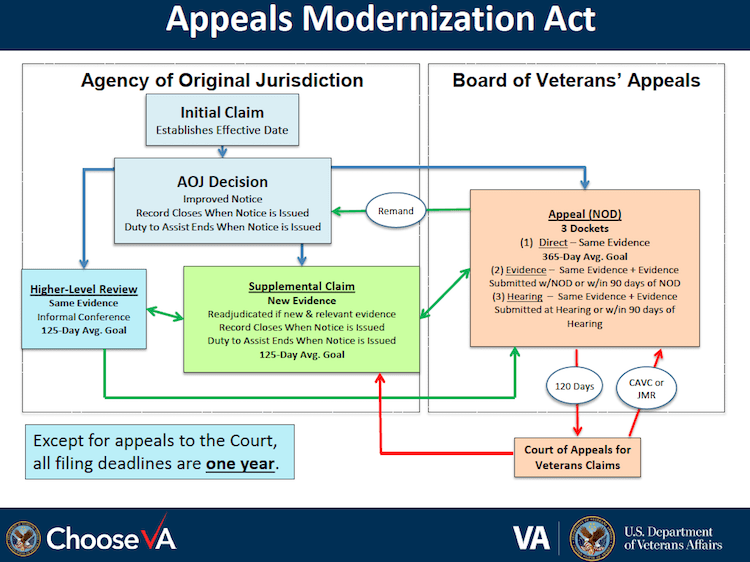In the past, I have talked to you about the VA Duty to Assist law, and how I think it’s largely, well, nothing to write home about.
That was the Duty to Assist under the Legacy Appeals process. Now, under the “modernized” appeals process, we are getting a new version of the VA Duty to Assist law. Call it the Duty to Assist 2.0. Or, the Diet Duty to Assist. Whatever you call it, the VA talked Congress into making them do even less for veterans than they currently do.
If that is even possible, am I right?
Okay, all kidding and obligatory mockery of the VA claims and appeals process aside, there have been some significant changes in the VA Duty to Assist law now that the AMA – or modernized appeals process – has gone into effect.
Before we dive into the new, modernized VA Duty to Assist law, let’s take a quick look at the new, modernized, appeals process. This graphic comes to us courtesy of the VA itself. Review it, and you tell me if you agree: it IS possible to invent a more complicated Hamster Wheel.
If you want to see how the VA describes the appeals options under the AMA Modernized Appeal process, take a look at this very thin description from the VA.If you prefer a little more meat on your plate, subscribe to the Veterans Law Blog and I’ll keep you up to date on the newest developments and changes in the modernized AMA appeal process.
So, that’s the process. In a nutshell. This is not the first – or the last – time I will talk about this process. For all the work that went into simplifying VA appeals, the process got one helluva lot more complicated for Veterans trying to navigate this system.
What I really want to talk about in this post is the Duty to Assist, in modernized appeals.
The AMA “Modernized” Duty to Assist.
The changes to the VA Duty to Assist law were instrumental to making sure that the VA appeals process became easier for the VA and BVA. You see, a lot of time was being spent helping veterans and survivors gather evidence, and not enough time was being spent adjudicating claims and appeals. At least according to the VA.
So here’s what they did:
- The VA Duty to Assist ONLY applies during an original or supplemental claim.
- Once the VA issues a Ratings Decision on a original or supplemental claim, the VA no longer has a duty to assist the veteran in developing evidence to substantiate the claim.
- The BVA has NO DUTY TO ASSIST you.
- If the BVA or CAVC identifies a “prejudicial” duty to assist error, it can remand the appeal to the VA to cure the failure to fulfill the duty to assist.
A few points to keep in mind:
-
- The VA does not have a duty to assist you if you choose a higher level review after the VA denies your claim.
- The BVA does NOT have a duty to assist you if you file an appeal to the BVA. The BVA could see a glaring evidentiary omission in the record and are not required to do a darn thing about it. So much for a veteran-friendly non-adversarial claims process.
- There are no remands at the BVA, except for remands from the BVA to the VA’s “AOJ,” or Agency of Original Jurisdiction.
Another important point to note – Regional offices don’t process regional claims anymore. As I predicted years ago, the VA has moved to a “national work queue,” which means your claims are being worked by a rater anywhere in the US. More on this, later.)
What this means for your VA Claims and Appeals.
I’ve said it before and I’ll say it again: don’t count on actual assistance from the VA’s Duty to Assist.
Most of the time, they do little more than send a couple letters to doctors, sometimes get all of your service records, and occasionally ask the JSRRC to corroborate a stressor event for a PTSD claim.
Veterans are better off helping themselves.
How do you do that?
It’s easier than you think. Follow the 8 Steps to Improve Your VA Claim or Appeal. You can read about all of the steps here, but the driving theme is that Veterans can – and should – take back the power in their own VA claims and appeals.
By taking back the power, we take back control of the outcome, and we have the power of choice.
We can choose to get in the hamster wheel and stay there until the VA decides they’ve spun you around enough.
Or, we veterans can choose to get the evidence we need to prove our own claims. We can assist ourselves rather than wait on the VA to fulfill its duty to assist.






